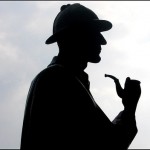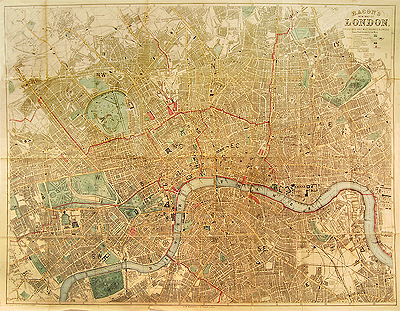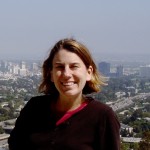 “A positive case can be made that [Sherlock] Holmes exerts just as much hold on the world’s imagination today as he did a century ago,” writes Joshua Hammer in a recent essay. And, he continues, “Conan Doyle’s other alluring creation was London.”
“A positive case can be made that [Sherlock] Holmes exerts just as much hold on the world’s imagination today as he did a century ago,” writes Joshua Hammer in a recent essay. And, he continues, “Conan Doyle’s other alluring creation was London.”
It is easy to appreciate the imaginative effort that produced Holmes, master detective and master of disguise, his brain a kind of compendium of raw data and a machine for deductive reasoning, his heart a refuge for unspoken demons and silent affections. It is perhaps more difficult to grasp the equally imaginative effort that produced Holmes’s London. But that place is also imagined, shaped by Conan Doyle’s narrative art into the proper setting of many of Holmes’s adventures and the surrounding context for 221B Baker Street, where most of the stories, no matter where they lead him and Watson, begin and end.  Holmes’s London partakes of the reality of the real city, the sprawling megalopolis documented by maps and photographs and record such as newspapers and police reports. But it also participates in a “fascinating and artistic” city more familiar from impressionist paintings and poems. Our image of end of the century London is, in no small thanks to Conan Doyle, a mixture of these two cities, full of foggy streets and mysterious riverbanks only partially illuminated by the glow of streetlamps.
Holmes’s London partakes of the reality of the real city, the sprawling megalopolis documented by maps and photographs and record such as newspapers and police reports. But it also participates in a “fascinating and artistic” city more familiar from impressionist paintings and poems. Our image of end of the century London is, in no small thanks to Conan Doyle, a mixture of these two cities, full of foggy streets and mysterious riverbanks only partially illuminated by the glow of streetlamps.
Holmes and Watson discuss the relationship between these two aspects of London in “A Case of Identity,” one of the stories that appeared in The Adventures of Sherlock Holmes in 1892:
“My dear fellow,” said Sherlock Holmes, as we sat on either side of the fire in his lodgings at Baker Street, “life is infinitely stranger than anything which the mind of man could invent. We would not dare to conceive the things which are really mere commonplaces of existence. If we could fly out of that window hand in hand, hover over this great city, gently remove the roofs, and peep in at the queer things which are going on, the strange coincidences, the plannings, the cross-purposes, the wonderful chains of events, working through generations, and leading to the most outré results, it would make all fiction with its conventionalities and foreseen conclusions most stale and unprofitable.”
“And yet I am not convinced of it,” I answered. “The cases which come to light in the papers are, as a rule, bald enough, and vulgar enough. We have in our police reports realism pushed to its extreme limits, and yet the result is, it must be confessed, neither fascinating nor artistic.”
“A certain selection and discretion must be used in producing a realistic effect,” remarked Holmes. “This is wanting in the police report, where more stress is laid, perhaps, upon the platitudes of the magistrate than upon the details, which to an observer contain the vital essence of the whole matter. Depend upon it there is nothing so unnatural as the commonplace.”
I think we can read this passage as a meditation on the kind of portrait of the city that Conan Doyle aspires to offer. That portrait will be at once accurate and “fascinating and artistic,” and it will achieve this double effect, this fusion of documentary accuracy and aesthetic imagination, by demonstrating how unpredictable and “strange” the everyday life of the city really is.
In this Sunday’s salon, we will examine the London depicted in “realistic” portraits such as maps and the London presented by artists such as Whistler and Wilde. We will see how Conan Doyle draws on both aspects of London to create Holmes’s city, which is not only a vivid setting but a character in its own right and an object of knowledge as well as mystery.
Submitted by Stephanie Weiner, Wesleyan University Associate Professor of English
 Stephanie Weiner (B.A., University of Minnesota; Ph.D., Stanford University) is associate professor of English at Wesleyan University. Her recent publications include Republican Politics and English Poetry, 1789-1874 (Palgrave Macmillan, 2005), and articles about Ernest Dowson, Algernon Swinburne, and Arthur Symons. She is currently at work on a book about the English Romantic poet and naturalist John Clare and a series of articles about depictions of real and imagined sense experience in late nineteenth-century poetry. She is the recipient of the Binswanger Prize for Excellence in Teaching (2010).
Stephanie Weiner (B.A., University of Minnesota; Ph.D., Stanford University) is associate professor of English at Wesleyan University. Her recent publications include Republican Politics and English Poetry, 1789-1874 (Palgrave Macmillan, 2005), and articles about Ernest Dowson, Algernon Swinburne, and Arthur Symons. She is currently at work on a book about the English Romantic poet and naturalist John Clare and a series of articles about depictions of real and imagined sense experience in late nineteenth-century poetry. She is the recipient of the Binswanger Prize for Excellence in Teaching (2010).
Interested in hearing more? Join us this weekend.
Sherlock Holmes’ London on Paper, Canvas, and Film
A Sunday Salon & Graduate Liberal Studies Open House
Sunday, November 21, 2010 | 2-4pm
Suggested Donation $5
Professor Weiner will examine how various representations of London managed to offer a fascinating snapshot of the city as it was. During the salon, Sir Arthur Conan Doyle’s stories, maps, and photographs as well as paintings by artists such as James Abbot McNeill Whistler, poems by writers such as Oscar Wilde, and recent Sherlock Holmes films will be examined. The Salon will include an information session about graduate liberal studies at Wesleyan, where Professor Weiner will be teaching a course on Literature in London this spring. To reserve a seat, contact Green Street Arts Center at 860-685-7871 or email gsac@wesleyan.edu.


